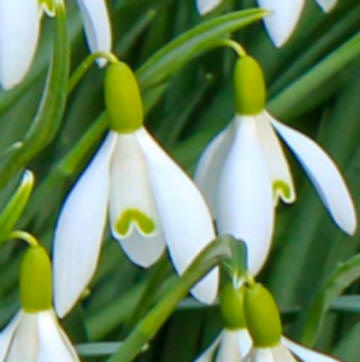Snowdrops

Photographer Felicity McCullough © 2021
Snowdrop
Perfectly formed, a bell-shaped snowdrop usually appears as a single stemmed white flower with three petals called tepals. A tepal refers to the outer part of the flower, forming part of the flower’s overall perianth. The snowdrop bulb may produce a single head bloom, or a double row head bloom in arrangement of multiple layers of petals, depending on the variety from a snowdrop bulb. The flower head has a light yellowish-green cap, resulting in the flower’s head mostly looking downward. Inner petals sometimes contain green or yellow marks, in the shape of a v-shaped boomerang as shown on the displayed photograph.
The leaves foliage is vibrant light green with upright narrow leaves that surround the flower’s stem.
Snowdrops flower early in the year usually during winter, often flowering when the snow is on the ground from a bulb. The ‘snow’ forms the first part of the name and the ‘drop’ refers to being similar to an ear ‘drop’, akin to an earring shape. The flowers are also known as ‘Candlemas Bells’, indicating the time of year they bloom in the northern hemisphere.
The snowdrop belongs to the bulb branch of the perennial hebaceaous Amaryllidaceae family and is specifically known by the small Galanthus genus. Galanthas nivalis the common snowdrop variety. The Latin interpretation means ‘milk’ ‘flower’. There can be mutant varieties, of various colours and shades, with detailed and intricate petal patterns, which are highly prized and each bulb can be quite valuable.
Collectors and identifiers of snowdrop species and cultivars are referred to as galanthophiles.
The snowdrop has been regarded as a sign of hope and purity. This is thought to have originated from the legend about Adam and Eve’s expulsion from the Garden of Eden. During winter Eve was sad as she thought she would never see the sunshine again. An angel who had been dispatched to watch over them, breathed on a snowflake creating the first snowdrop. After repeating this many times, Eve was surrounded by snowdrop flowers. The angel explained to Eve that the flower showed that winter would pass, flowers would bloom again and the sun would shine, and had given Eve the ‘Gift of Hope’, as the sun would shine once again in the spring.
As the flowers appear flawless they also symbolise purity.
Snowdrop bulbs grow well under trees and shrubs in groups at the front of the border. The perennial establishes better, if planted ‘in-the-green’ after flowering.
Felicity McCullough
26 January 2021 ©
Keywords
Snowdrops, snow northern hemisphere, January, February, bell-shapes, white, flowers, green, markings, segments, nestle, green, upright, narrow, leaves, tiny, size, growing, bulb single-stem flower, topped, cap, Galanthus nivalis, milk snow-like flower, autumn, or in-the-green, flowered, low-growing, perennials, multiply, undisturbed, clumps, spread, lifted thinned, dense, planted, depth, groups, distance, Woodland, environment, light-shade, trees, grass. Moss, groundcover, deciduous, shrubs, border, naturalised, Snowdrop, gardens pots bulbs, well-drained, soil, sand and grit, Grey squirrels, pest, dig-up, eat bulbs, varieties, popular, white and green, flowers, although yellow varieties, variants, bulb varieties, garden, centres, shops, rarer, cultivar, varieties, distinguished, markings, inner, three, petals, single, bulb, specialists,
